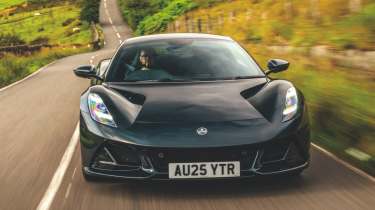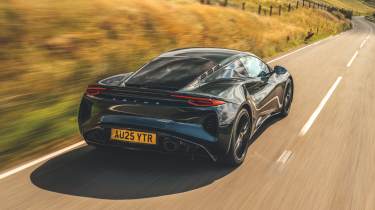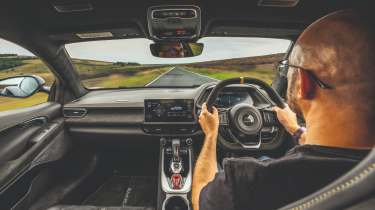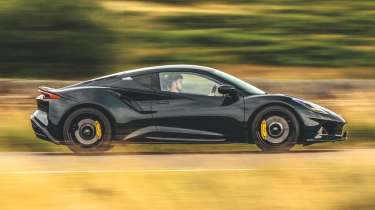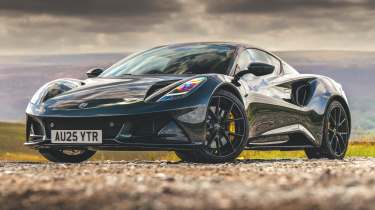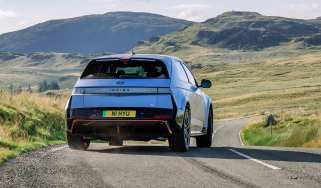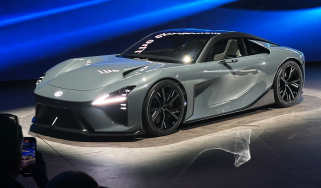Lotus Emira Turbo SE 2025 review – a rebranded sports car with detail tweaks
Amidst all the current hullabaloo at Hethel, a faster, sharper Emira four‐cylinder has emerged. Could it be the new pick of the range?
First things first: we’re not going to discuss politics. What’s proved a useful rule in polite conversation for decades now has a fresh pertinence when getting to the nitty-gritty of a new Lotus. Does Hethel have a future? How long will the latest boss stick around for? There’s certainly lots to discuss on the industry side of the Norfolk brand right now. Best to simply focus on the car. For all its curious, occasionally calamitous sub-plots, the main Lotus arc has always been its engineering nous and welterweight sports cars. And the Emira is an intriguing one.
In evo 336, during our giant ‘sports car state of play’ test, it scored four stars, finished third and was declared a bit of a work in progress in V6 manual form; a car with more potential and precision to be unlocked. Does that lie in this Emira Turbo SE? Whisper it – because this feels like a sordid confessional on the pages of evo – but it was always the AMG-powered, DCT-shifted car that excited me more when the Emira made its world premiere.
I’d driven countless Exige and Evora specials with the familiar Toyota-sourced 3.5-litre slotted neatly in the middle, and kinda loved them all – the brutish focus of later Exiges in particular. But the Emira arrived amidst a new chapter in Lotus history, ensuring the more contemporary pairing of downsized four-cylinder turbo with whipcrack paddleshifts piqued my interest more, not least for its proposed £59,995 price tag.
Alas, since editor-in-chief Gallagher drove the launch i4 back in 2023, priced at a smidge over eighty grand in First Edition form, the Hethel sands have shifted again. The Emira range now kicks off at £79,500 for the 360bhp Turbo, which replaces the i4, and this new, more powerful Turbo SE weighs in ten grand heftier before options. If that sounds a lot, then it at least undercuts the V6 SE by seven grand while also outperforming it on paper.
More reviews
The Turbo SE badge is familiar from the Esprit family tree. It was attached to the supercar wedge between 1989 and 1994 in what proved to be one of its bestselling iterations. Over a stock Esprit Turbo, it added another 40-odd horsepower, a bunch of extra equipment and the claim of being the quickest road-going Lotus yet. The recipe hasn’t really changed: here the 2-litre M139 engine is now 40bhp healthier, several option boxes have been ticked and it’s the quickest roadgoing Emira yet, notching 181mph and 0-62mph in 4.0sec – four tenths quicker than a base Turbo.
The engine now sits much closer to some of its Mercedes-AMG donors, allaying some of our disappointment when the launch car fell short. Still, its 400bhp and 354lb ft peaks lag a smidge behind an AMG A45 S or AMG GT43 coupe – albeit with half a ton less to carry and a £15k saving. Add AMG’s SL43 and the Alpine A110 into the mix and there’s a surprising number of four-cylinder options nudging (or exceeding) six-figure prices.
Those slinking over the Emira’s carpeted sill from a larger-capacity sports car are forgiven a sigh of disappointment the first time they start the Turbo SE. Much as Stu found with the i4, there’s a dearth of drama as the engine snaps into life and then idles. Slot its fiddly gear selector into D – you must tug its central protrusion twice to get going, like a modern ode to double declutching – and you’ll pull away with a sound not dissimilar to that of an old Exige S2: a mainstream four-cylinder rattle rather than the gruffer, bassier tune played by those AMGs.
The gearbox is calibrated well, though, and an eight-speed DCT fits this engine far better than any manual could. It feels finely tuned in relaxed driving, shuffling up through just enough ratios to be polite – and boost its impressive efficiency – without leapfrogging to the highest possible gear. Gently twisting A-roads tend to see it in fifth or sixth, primed and ready for an inviting string of corners without sitting coarsely at high revs. They’re nice short ratios, too, with second all wrung out before 60mph. You’re soon inspired to flick up and down the ’box yourself with the paddles, making it a shame they’re not as tactile as an Alpine’s and don’t click home with much oomph.
Another bugbear is the ride. The Turbo SE kit haul brings the tougher Sport suspension as standard, a set-up we’ve critiqued before. It remains taut and intrusive through town while bringing unwelcome busyness – and often kickback – over bumpier rural roads. Drive the Emira relatively gently, making progress without intensively engaging in it, and it leads you to a sense that it could be a bit of a handful with speed.
Thankfully it’s not, and its composure swells with your commitment. As James Taylor found with the V6, this is a car that feels fabulous over the bumps and crests of a challenging B-road – you just need a bit of pace under its wheels and pressure in its damping to tease out its true focus. You can option the SE on softer Touring suspension, however, and I suspect it’ll be a more rounded road car so equipped.
And that would be fitting, because this is otherwise the most useable Lotus I’ve driven. Though evo is rarely the place to obsess about luggage or fuel efficiency, the Emira offers useful numbers in both areas. The bijou boot combines with copious space behind the two seats for a 359-litre combined volume making up for its lack of frunk space – while you can easily extract mid-30s mpg and over 400 miles from a tank for proper grand touring capability.
That’s something you might truly embrace when there’s such a high-grade cabin. Leather and Alcantara swathe almost every surface and it all feels properly screwed together. Its central touchscreen is perfectly positioned and easily mirrors your phone display for an experience that’s aeons ahead of the old aftermarket head units hoofed reluctantly into Evora dashboards – even if the audio struggles in its fight against road roar at a brisk cruise. The Emira may cost a heck of a lot more than we’d hoped, but the stunning, Evija-infused styling on the outside is backed up by some genuine quality inside. If you pack smartly, it could feasibly be your only car. This is Lotus properly eating into the space dominated for decades by Porsche.
Tyre-wise you’ve a choice of Goodyear Eagle F1s or Michelin Cup 2s, and this is our first taste of a turbocharged Emira with the former. A back-to-back comparison would prove conclusive, but the latter are surely the better bet if you’re buying this car to truly relish the driving experience. The Goodyears are faithful on road, mind, and the steering helps bridge any gaps in communication. A rack that feels overly resistant at low speeds has a wonderful firmness and cohesion to it with harder cornering. The brakes feel good too and encourage you to lean later and later on the pedal as you learn to decipher the car’s initially blurry stream of communication.
What it never quite achieves on road is a truly playful character, its handling balance proving honed and precise but not especially expressive. It feels like it would be a deft circuit car, with the accuracy and consistency of a shrunken prototype racer. Flicking through its Tour, Sport or Track modes (the third of those part of the Turbo SE equipment boost alongside Launch Control) only serves to liven up the gearbox map and exhaust note, while toggling through the various stages of electronic intervention doesn’t do much to change the car’s attitude. Which is a credit to how well the chassis is set up in the first place and the subtle interventions of those nannies when they do help out.
Time is generous to this car, wary first impressions morphing into a warmer connection as the miles pass by. The engine just never steps up from functional to inspirational. Its various chuffs, whistles and huffs bring a welcome dose of theatre, but its power delivery feels punchy and efficient rather than rousing or effervescent. You ride its wave of torque and snap those gearshifts home rather than savouring every rev. ’Twas ever thus in the turbocharged world, of course, and it’s undoubtedly a quick car.
If you’re buying an Emira as a last throw of the dice for involving, internal-combustion sports cars, the V6 is probably still the one. But if you want (or need) to have your car with just two pedals, the Turbo makes a strong case for itself in either of its trims. A switch back to Touring suspension might negate some of the Turbo SE schtick, and I’m sure the base car’s 360bhp hit is nearly as strong. But there are some useful extra goodies here and the emotive badge might just assuage any fears that a four-cylinder Emira is copping out.
It’s a convincing overall package, the twin-clutch transmission further boosting the Emira’s case as an everyday proposition. A Cayman GTS continues to outgun it in most objective ways, costing a fair heap less with two additional cylinders and twice the engine capacity. On paper it’s a done deal. But if you’re already versed in Porsche ownership or simply crave the superstar looks and enigmatic image a 718 can’t quite muster, the Turbo SE is a compelling alternative. No matter what’s going on at Hethel.
Price and rivals
At the car’s launch Lotus spoke of a sub-£60,000 Emira but a lot's transpired over the last three years. As such in 2025 this four-cylinder turbocharged Emira SE is now an £89,500 proposition at minimum, with its V6 manual counterpart now approaching £100k once options are accounted for.
Yet for under £87k you can buy into BMW's latest hottest small coupe, the new M2 CS. Though not lightweight by comparison and lacking the ideal mid-engine layout of the Lotus, it's more practical and promises a focus all of its own, in addition to the M2's inherent muscle car character. The Porsche Cayman GTS 4.0 with its extra cylinders would be the obvious pick, but the 718s as we know them will be out of production by the end of the year... and the Alpine A110 won't be long behind it. So the Lotus all of a sudden looks like it has a clear run of it ahead, if it sticks around...
Specs
| Engine | In-line 4-cyl, 1991cc, turbocharged |
|---|---|
| Power | 400bhp @ 6800rpm |
| Torque | 354lb ft @ 3000rpm |
| Weight | 1455kg |
| Power-to-weight | 279bhp/ton |
| Tyres as tested | Goodyear Eagle F1 SuperSport |
| 0-62mph | 4.0sec |
| Top speed | 181mph |
| Price new | £89,500 |
